Roofing Companies Inverkeithing
Find top Roofing Contractor in Inverkeithing
Get multiple Roofing Company quotes for your project today! Compare profiles, reviews, accreditations, portfolio, etc... and choose the best service.
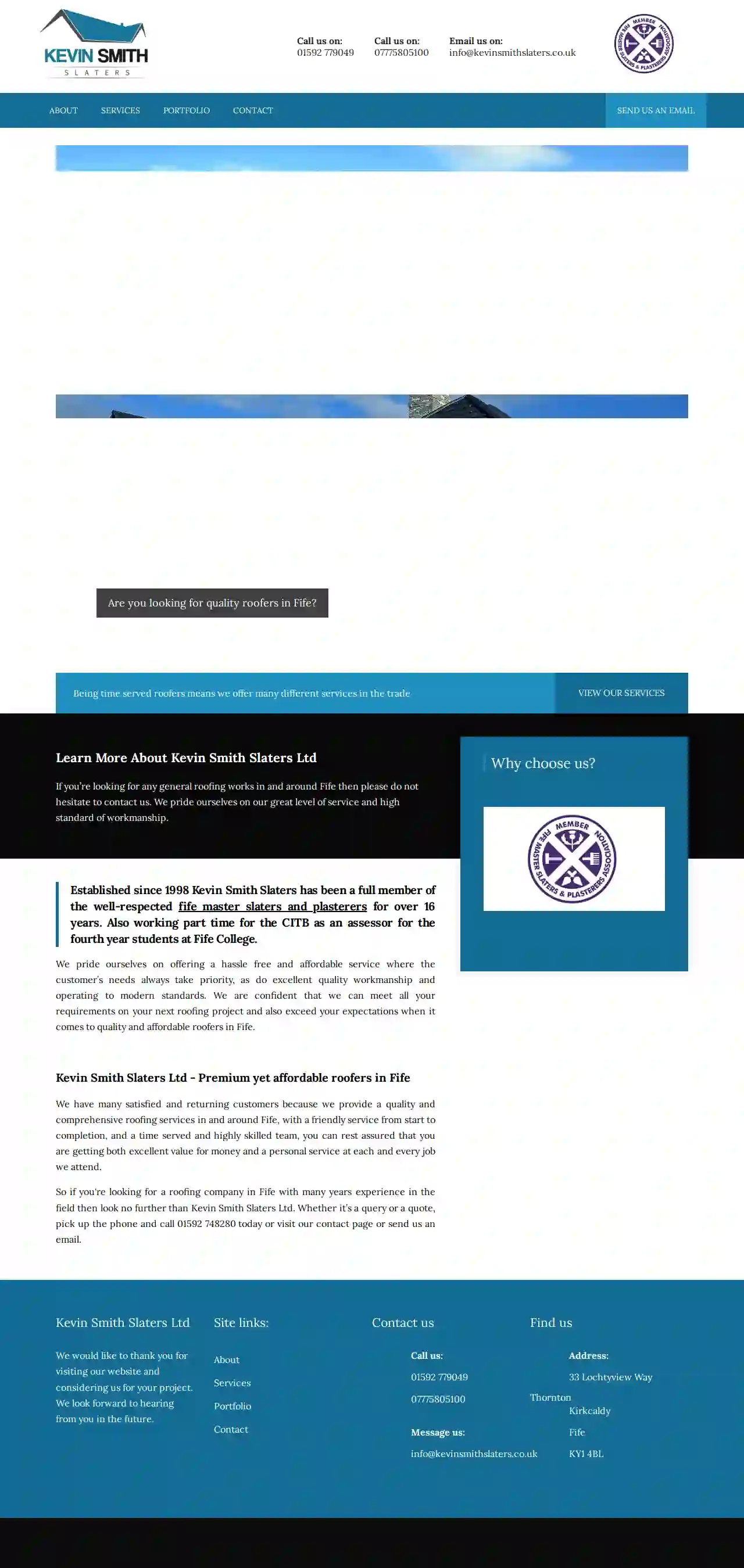
Kevin Smith Slaters
33, Lochtyview Way, Thornton, KY1 4BL, GBKevin Smith Slaters Ltd is a time served roofing company based in Fife, Scotland. With over 16 years of experience, we offer a wide range of services including slating, tiling, roughcasting, and specialist rendering. Our team of skilled and friendly professionals pride themselves on providing a hassle-free and affordable service, with a focus on excellent quality workmanship and operating to modern standards. We have built up a solid base of satisfied customers and are confident that we can meet all your requirements on your next roofing project and exceed your expectations when it comes to quality and affordability.
- Services
- Why Us?
- Gallery
Get Quote
Armour Roofing and Slating Ltd.
59 reviews34 Hawksmuir, Kirkcaldy, KY1 2PW, GBWelcome to Armour Roofing and Slating Services Ltd, your trusted roofing company in Fife. With over 21 years of expertise, we are fully SVQ Qualified, Trained Roofing Contractors specialising in Roofing, Slating, Tiling, Firestone Rubber Cover & Felt Roofing. Our commitment is to provide high-quality roofing solutions with a hands-on approach, ensuring that every project meets the highest of standards. If you’re in need of reliable Roofers in Fife, or comprehensive Roofing Services, look no further. From emergency roof repairs to complete new roof installations, Armour Roofing and Slating is your trusted partner. Based in Kirkcaldy, we’ve built a strong reputation, proudly serving an expanding customer base across Fife, including areas like Kirkcaldy, Dunfermline, Glenrothes, St. Andrews, Cupar, Leven, Anstruther etc. At Armour Roofing and Slating, customer satisfaction is our top priority. Our dedicated team of roofing experts, specialising in Slate Roofing, Tiling, Rubber Roofing & Felt Roofing, is dedicated to meeting your needs. Discover why a significant portion of our business comes from satisfied customers and word-of-mouth referrals. Explore our services and contact us for all your roofing needs.
- Services
- Why Us?
- Our Team
- Testimonials
- Gallery
Get Quote
RPS Roofing & Building LTD
4.813 reviewsDunfermline, GBRPS Roofing & Building is a team of highly trained and qualified roofers based in Dunfermline, Scotland. We are Scotland’s premier listed and conservation property specialists, offering a wide range of roofing and building services throughout Scotland. No job is too big or too small for our team, and we pride ourselves on providing 100% customer satisfaction. We offer free quotations and 24-hour emergency call-out services. All our repair work is guaranteed for up to 5 years, and new roof installations are guaranteed for 20 years.
- Services
- Why Us?
- Testimonials
- Gallery
Get Quote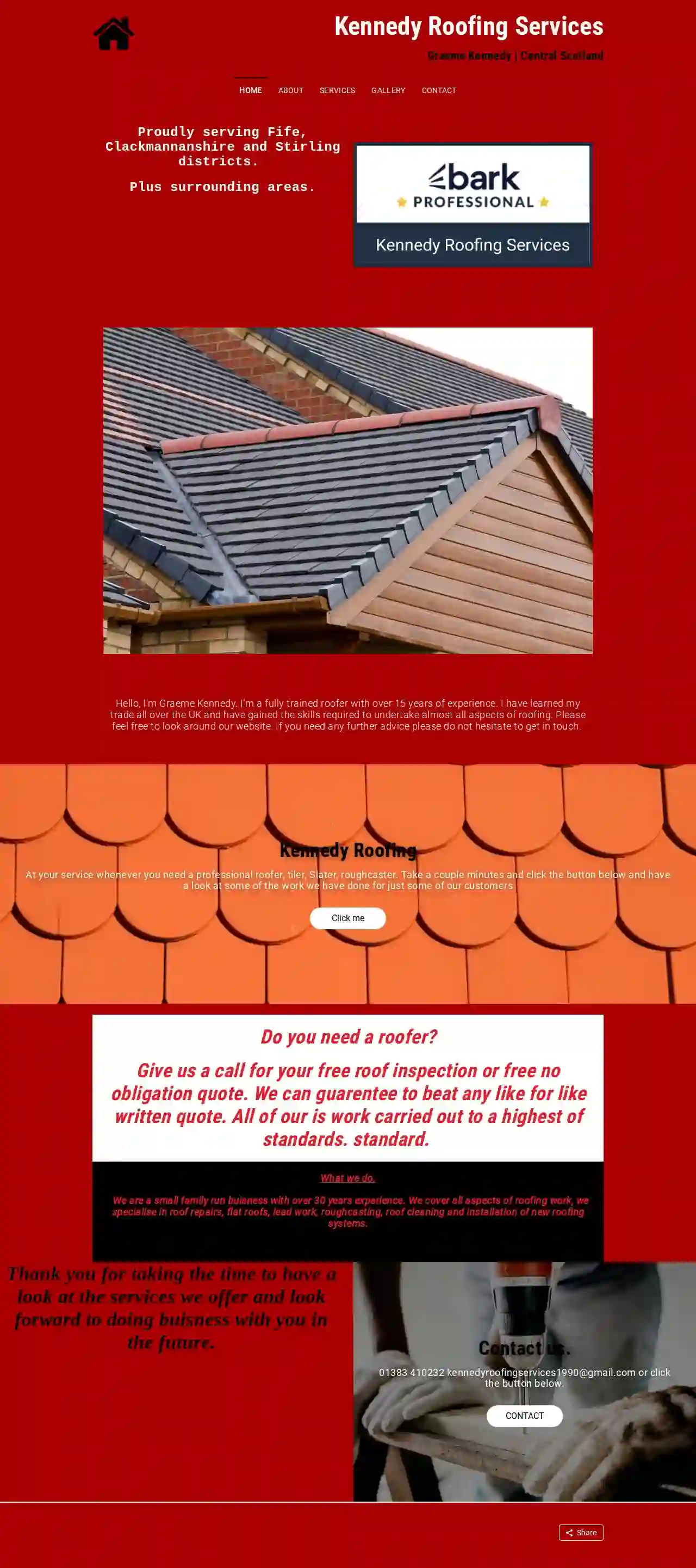
Kennedy Roofing Services
582 reviews142 Primrose Avenue, Rosyth, KY112TZ, GBProudly serving Fife, Clackmannanshire and Stirling districts. Plus surrounding areas. Hello, I'm Graeme Kennedy. I'm a fully trained roofer with over 15 years of experience. I have learned my trade all over the UK and have gained the skills required to undertake almost all aspects of roofing. Please feel free to look around our website. If you need any further advice please do not hesitate to get in touch. Kennedy Roofing At your service whenever you need a professional roofer, tiler, Slater, roughcaster. Take a couple minutes and click the button below and have a look at some of the work we have done for just some of our customers. Click me Do you need a roofer? Give us a call for your free roof inspection or free no obligation quote. We can guarantee to beat any like for like written quote. All of our work is carried out to the highest of standards. What we do. We are a small family run business with over 30 years experience. We cover all aspects of roofing work, we specialise in roof repairs, flat roofs, lead work, roughcasting, roof cleaning and installation of new roofing systems. Thank you for taking the time to have a look at the services we offer and look forward to doing business with you in the future. Contact us. 01383 410232 [email protected] or click the button below. CONTACT
- Services
- Why Us?
- Our Team
- Testimonials
- Gallery
Get Quote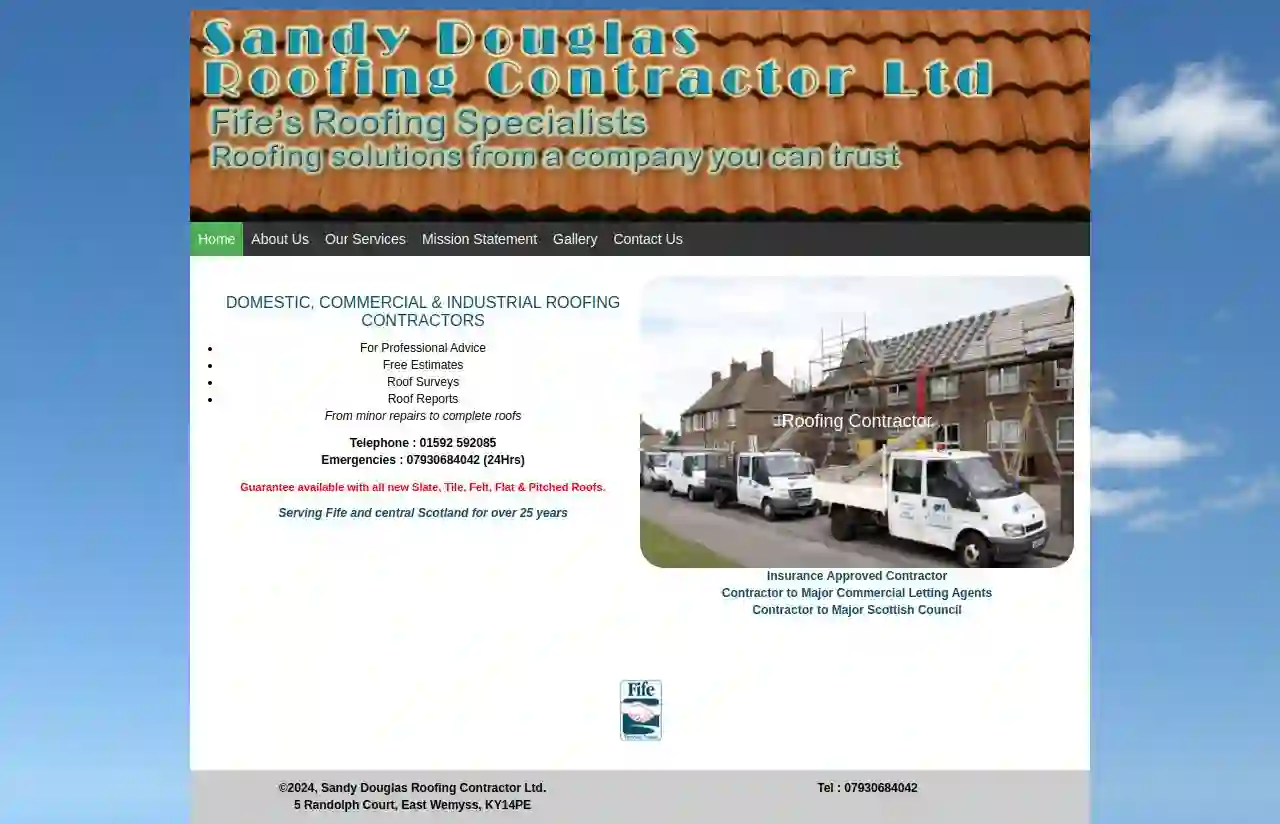
Sandy Douglas Roofing
510 reviewsEast Wemyss, 5 Randolph Court, KY14PE, GBSandy Douglas Roofing Contractor Ltd. is a professional roofing contractor based in Fife and central Scotland, serving the region for over 25 years. We offer a wide range of services, from domestic and commercial roofing to industrial and property maintenance. Our team of experts is dedicated to providing high-quality workmanship and excellent customer service. With a guarantee available on all new slate, tile, felt, flat, and pitched roofs, you can trust us to get the job done right. Contact us today for a free estimate and let us help you with all your roofing needs.
- Services
- Why Us?
- Accreditations
- Our Team
- Gallery
Get Quote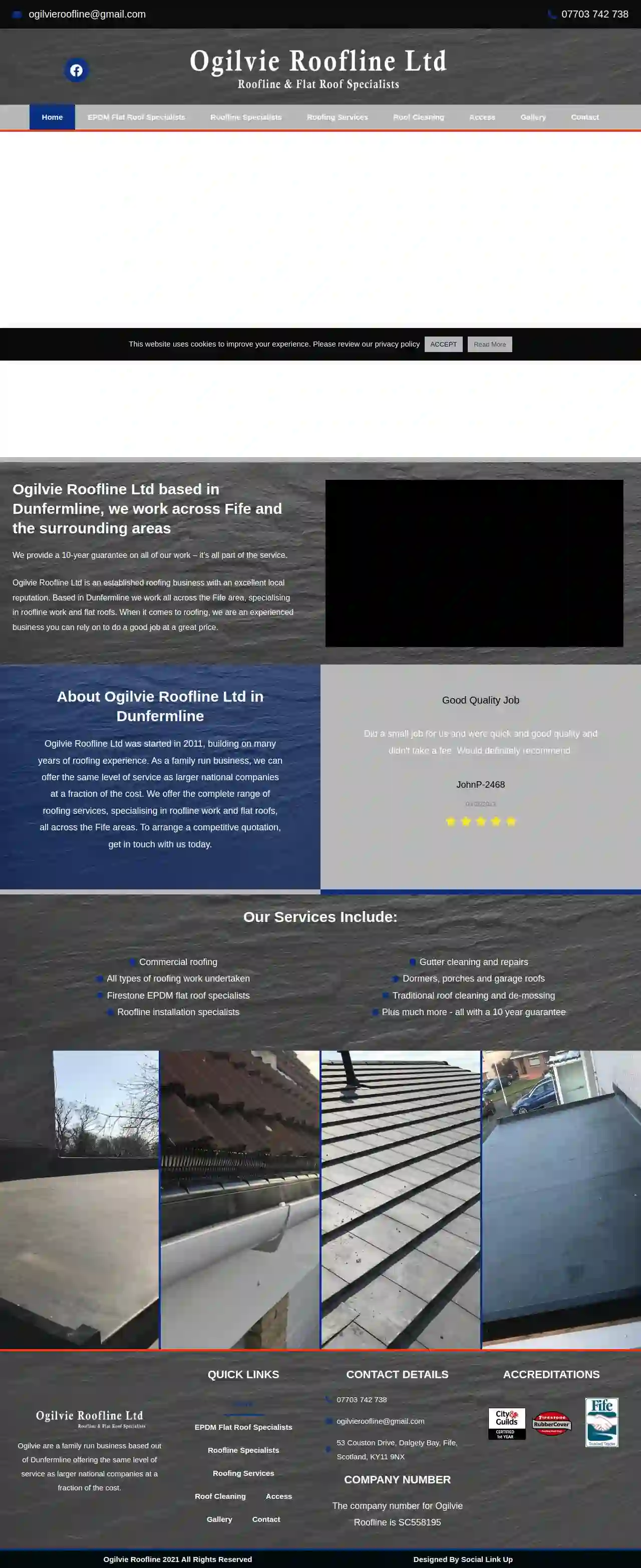
Ogilvie Roofline & Flat Roof Specialists
59 reviews53 Couston Drive, Dalgety Bay, KY11 9NX, GBOgilvie Roofline Ltd is an established roofing business with an excellent local reputation. Based in Dunfermline we work all across the Fife area, specialising in roofline work and flat roofs. When it comes to roofing, we are an experienced business you can rely on to do a good job at a great price. Ogilvie Roofline Ltd was started in 2011, building on many years of roofing experience. As a family run business, we can offer the same level of service as larger national companies at a fraction of the cost. We offer the complete range of roofing services, specialising in roofline work and flat roofs, all across the Fife areas. To arrange a competitive quotation, get in touch with us today.
- Services
- Why Us?
- Accreditations
- Our Team
- Testimonials
- Gallery
Get Quote
Mark Ramsay Roofing
51 reviewsKirkcaldy, Fife, Mark Ramsay roofing and roughcasting, KY1 1TY, GBMark Ramsay roofing and roughcasting was established in 2012 by owner Mark Ramsay, who brings years of experience and a wealth of local knowledge to every project. Mark's hands-on approach ensures professional workmanship and high standards, guaranteeing quality on every job. We offer environmentally friendly, functional, and stylish services. Our expert suppliers use materials that are kind to the planet, and we dispose of all waste responsibly. As a recommended and trusted company, we can work with your insurance and grant work enquiries. With a team of 3 experienced tradesmen, 2 labourers, and an apprentice, our jobs are completed efficiently, safely, and most importantly, affordably. We primarily serve the domestic market and have a strong reputation for excellent customer service. We also collaborate with various local commercial and council contractors in the new build sector and homeowners in Fife and Lothian.
- Services
- Why Us?
- Gallery
Get Quote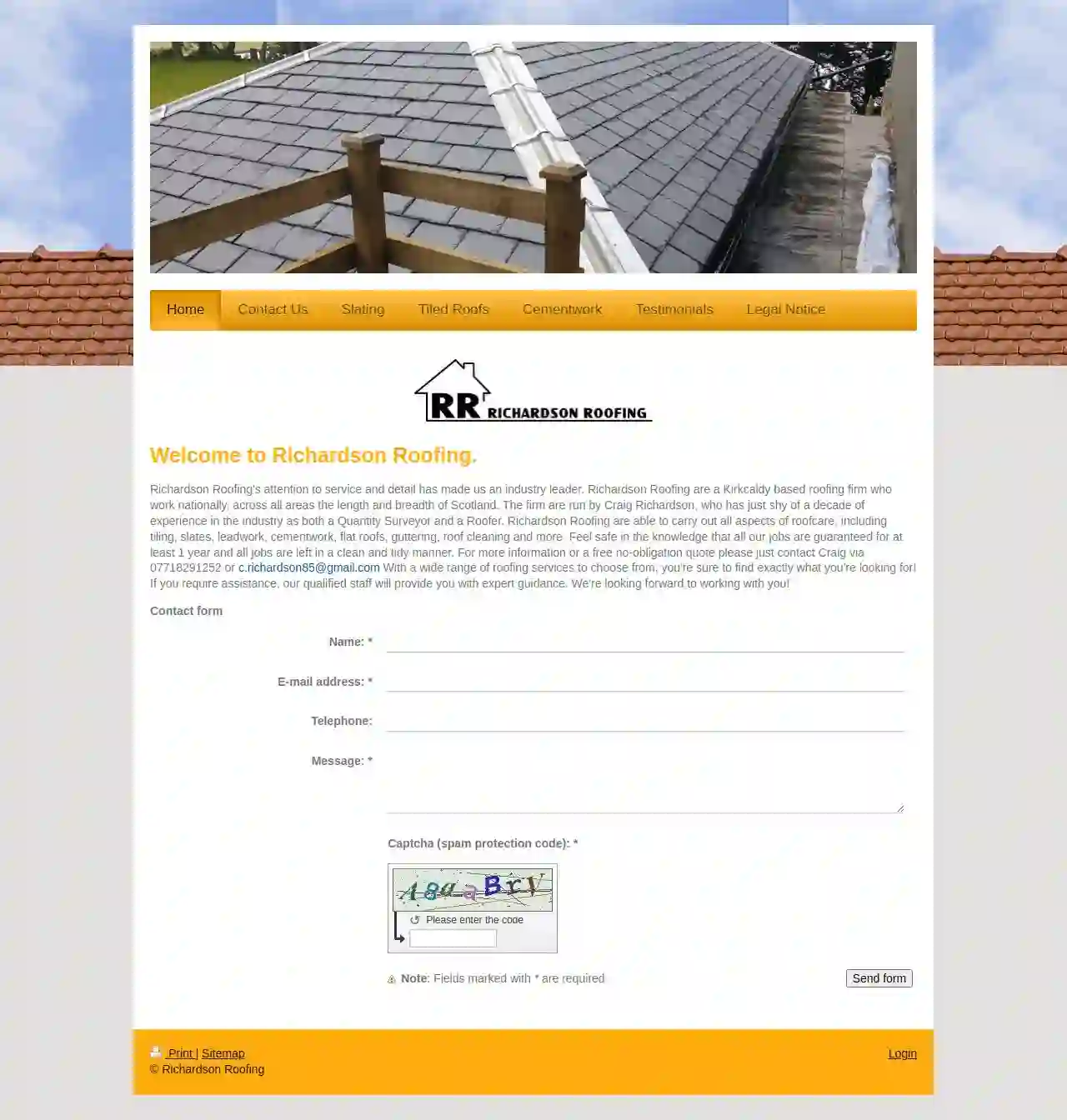
Richardson Roofing
51 reviewsKirkcaldy, GBRichardson Roofing's attention to service and detail has made us an industry leader. Richardson Roofing are a Kirkcaldy based roofing firm who work nationally, across all areas the length and breadth of Scotland. The firm are run by Craig Richardson, who has just shy of a decade of experience in the industry as both a Quantity Surveyor and a Roofer. Richardson Roofing are able to carry out all aspects of roofcare, including tiling, slates, leadwork, cementwork, flat roofs, guttering, roof cleaning and more. Feel safe in the knowledge that all our jobs are guaranteed for at least 1 year and all jobs are left in a clean and tidy manner. With a wide range of roofing services to choose from, you're sure to find exactly what you're looking for! If you require assistance, our qualified staff will provide you with expert guidance. We're looking forward to working with you!
- Services
- Why Us?
- Our Team
- Gallery
Get Quote
The Conservatory Converters
3.747 reviewsRosyth, Unit 6, Dunfermline Business Park Primrose Lane, KY11 2SF, GBThe Conservatory Converters are a leading provider of tiled conservatory roof conversions in Scotland. With over 20 years of experience, they have completed thousands of successful projects across the country, transforming conservatories into comfortable and usable living spaces year-round. Their team of skilled tradesmen uses a revolutionary and unique lightweight tiled roofing system to insulate and tile existing conservatory roofs, offering a cost-effective and efficient solution. The Conservatory Converters pride themselves on their honest and transparent services, providing a 10-year guarantee for peace of mind. They are FMB approved and committed to delivering high-quality workmanship and customer satisfaction.
- Services
- Why Us?
- Accreditations
- Our Team
- Testimonials
- Gallery
Get Quote
J Terotech
Dunfermline, GBJ Terotech Limited is a contracting and consultancy company who specialise in the maintenance, repair and refurbishment of roofs, buildings and structures. Our team of facilities and project management professionals have over 40 years' experience in advising, identifying, analysing and solving the problems of weather-proofing and water-proofing in the construction industry. We use state of the art technology, product and support services to offer a professional turnkey operation, encompassing initial investigation, recommendation, specification, system selection, implementation and on-site quality control - all tailored to the individual client requirements. From trouble-shooting repair projects to long-term maintenance programmes - our in-depth knowledge and professional approach will guarantee a cost effective solution.
- Services
- Why Us?
- Gallery
Get Quote
Over 12,314+ Roofers on our directory
Our roofing contractors operate in Inverkeithing & surrounding areas!
Roofyng.co.uk has curated and vetted the Best Roofing Businesses in and around Inverkeithing. Find a top & reliable pro today.
Frequently Asked Questions About Roofing Companies
- Safety First: Avoid going onto the roof during a storm, as it's dangerous.
- Document the Damage: Take photos and videos of the damage for insurance purposes.
- Contact Your Insurance Company: Report the damage to your insurance company as soon as possible to initiate a claim.
- Temporary Repairs: If safe, address any immediate leaks using buckets or tarps to minimize further damage.
- Contact a Roofing Contractor: After the storm, have a qualified roofing contractor inspect the roof and provide a repair estimate.
What is the difference between a roofer and a general contractor?
Roofer: Specializes in roof installations, repairs, and replacements. They have expertise in roofing materials, techniques, and safety practices specific to roofing.
General Contractor: Oversees and manages entire construction projects, including hiring and coordinating subcontractors, such as roofers, electricians, plumbers, etc. They handle overall project planning, scheduling, and budgeting.
For roofing projects, it's generally best to hire a roofing contractor who specializes in roof work.
What should I do with my old roof after replacement?
What should I do if my roof is damaged in a storm?
What is fascia, and why is it important?
What is the difference between a roofer and a general contractor?
Roofer: Specializes in roof installations, repairs, and replacements. They have expertise in roofing materials, techniques, and safety practices specific to roofing.
General Contractor: Oversees and manages entire construction projects, including hiring and coordinating subcontractors, such as roofers, electricians, plumbers, etc. They handle overall project planning, scheduling, and budgeting.
For roofing projects, it's generally best to hire a roofing contractor who specializes in roof work.
What should I do with my old roof after replacement?
What should I do if my roof is damaged in a storm?
- Safety First: Avoid going onto the roof during a storm, as it's dangerous.
- Document the Damage: Take photos and videos of the damage for insurance purposes.
- Contact Your Insurance Company: Report the damage to your insurance company as soon as possible to initiate a claim.
- Temporary Repairs: If safe, address any immediate leaks using buckets or tarps to minimize further damage.
- Contact a Roofing Contractor: After the storm, have a qualified roofing contractor inspect the roof and provide a repair estimate.